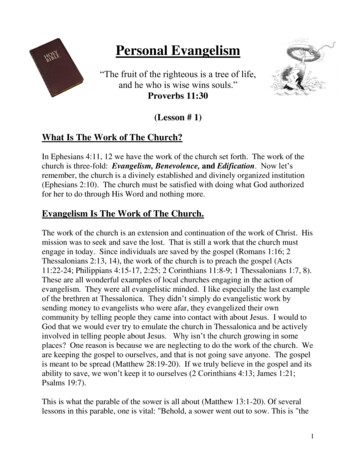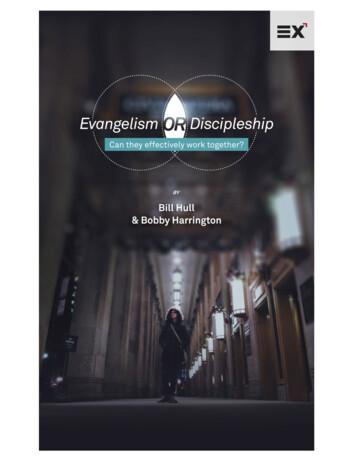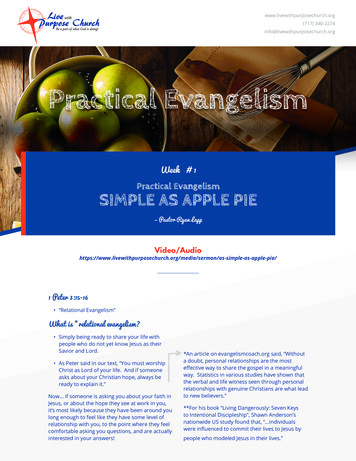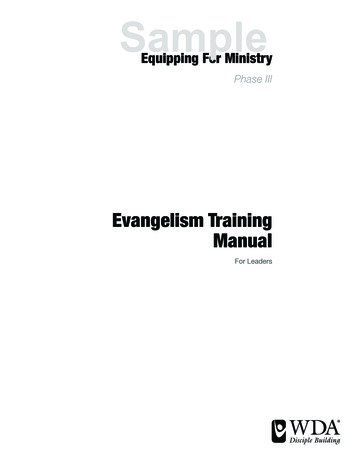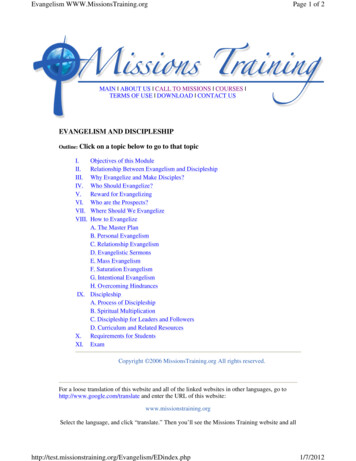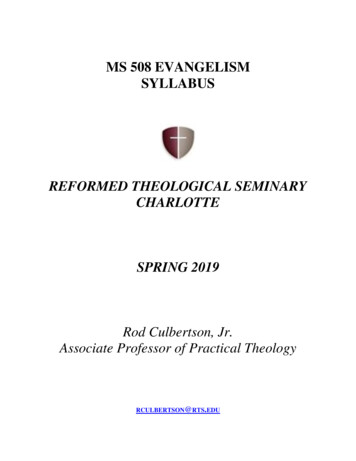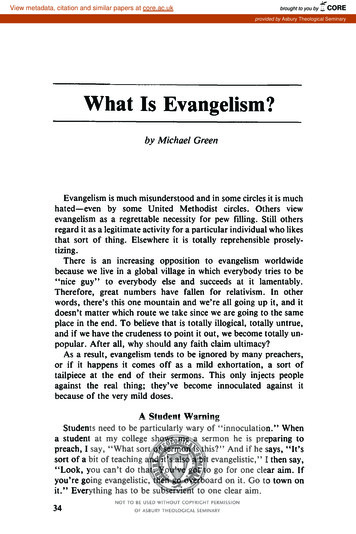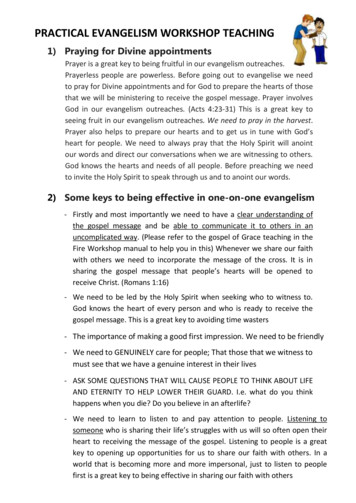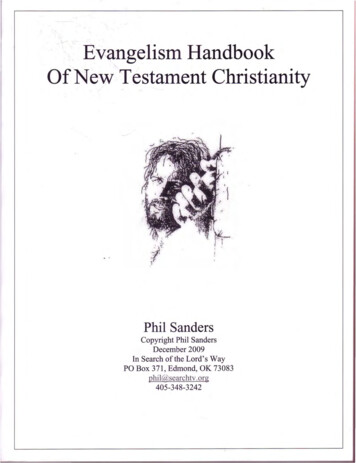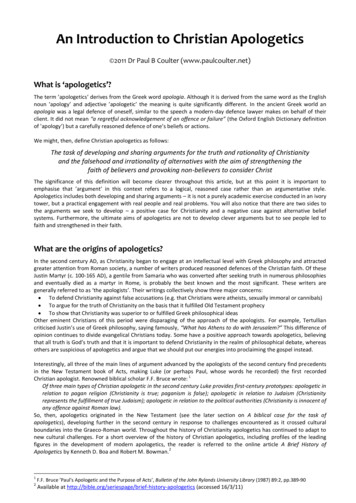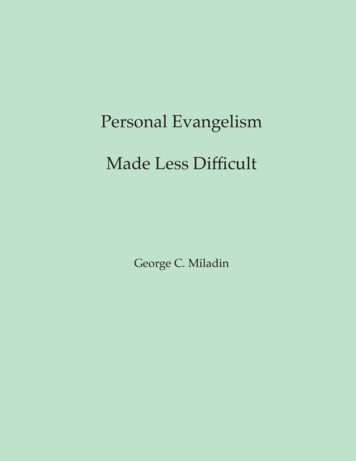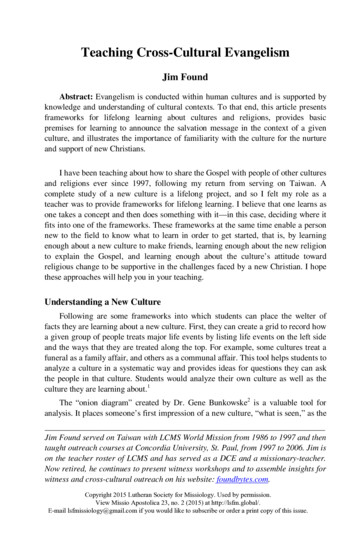
Transcription
Teaching Cross-Cultural EvangelismJim FoundAbstract: Evangelism is conducted within human cultures and is supported byknowledge and understanding of cultural contexts. To that end, this article presentsframeworks for lifelong learning about cultures and religions, provides basicpremises for learning to announce the salvation message in the context of a givenculture, and illustrates the importance of familiarity with the culture for the nurtureand support of new Christians.I have been teaching about how to share the Gospel with people of other culturesand religions ever since 1997, following my return from serving on Taiwan. Acomplete study of a new culture is a lifelong project, and so I felt my role as ateacher was to provide frameworks for lifelong learning. I believe that one learns asone takes a concept and then does something with it—in this case, deciding where itfits into one of the frameworks. These frameworks at the same time enable a personnew to the field to know what to learn in order to get started, that is, by learningenough about a new culture to make friends, learning enough about the new religionto explain the Gospel, and learning enough about the culture’s attitude towardreligious change to be supportive in the challenges faced by a new Christian. I hopethese approaches will help you in your teaching.Understanding a New CultureFollowing are some frameworks into which students can place the welter offacts they are learning about a new culture. First, they can create a grid to record howa given group of people treats major life events by listing life events on the left sideand the ways that they are treated along the top. For example, some cultures treat afuneral as a family affair, and others as a communal affair. This tool helps students toanalyze a culture in a systematic way and provides ideas for questions they can askthe people in that culture. Students would analyze their own culture as well as theculture they are learning about.1The “onion diagram” created by Dr. Gene Bunkowske2 is a valuable tool foranalysis. It places someone’s first impression of a new culture, “what is seen,” as theJim Found served on Taiwan with LCMS World Mission from 1986 to 1997 and thentaught outreach courses at Concordia University, St. Paul, from 1997 to 2006. Jim ison the teacher roster of LCMS and has served as a DCE and a missionary-teacher.Now retired, he continues to present witness workshops and to assemble insights forwitness and cross-cultural outreach on his website: foundbytes.com.Copyright 2015 Lutheran Society for Missiology. Used by permission.View Missio Apostolica 23, no. 2 (2015) at http://lsfm.global/.E-mail lsfmissiology@gmail.com if you would like to subscribe or order a print copy of this issue.
256 Missio Apostolicaoutermost of a series of concentric circles. Each layer represents a deeper insight intothat culture, finally reaching the center, called “ultimate allegiance.” That allegiancemight be to a local god, to the tribe, and often to family. The circle adjacent to thecenter is labeled “worldview”; the rest of the circles serve as paths to apprehendingthat worldview.Another useful activity is constructing “contrasting pairs” of attitudes, such as“time-oriented versus event-oriented,” in which the students determine where theculture fits along the spectrum between the two extremes. Students themselves cancreate more such pairs.3 It is important to note that an individual one meets inanother culture may deviate from his own culture’s norms to some degree. Thedesire to find out what that individual really thinks helps to determine what to talkabout with him.Pointers for those planning to enter a new culture include the following: (1) Seeyourself as a learner, not as one who knows all the answers and needs to enlightenthose to whom you are sent. (2) See yourself as a servant, not as a criticizer. (3) Bedetermined to adapt to the customs of the culture, even those you do not agree with.(One American I knew who came to Taiwan seemed to be on a personal crusade tobreak down the taboos of the locals and free them up to be more like Americans. Hisactions actually impeded building trust with the host culture). (4) Be content to takethe role of guest. You will never be an insider, but being a guest gives people of theother culture a chance to show hospitality and frees you from the unspokenobligations expected of a native. On Taiwan, for example, there are unwritten rulesof gift-giving, which the foreign visitor is not expected to know. (5) Regard yourfeelings of dependency as an asset for bonding. (You’re giving the host people achance to play the role of helper.) (6) Visualize cultural barriers such as language,age, and differences in education level or social stratum as “stepping stones” to becrossed.Language study is an essential part of understanding a culture. Manycharacteristics of a culture are embedded in its expressions and proverbs. Using theheart language engages you more deeply in conversation. Asking for help in thelanguage is a method for getting to know people. On Taiwan, I used to carry a photoalbum of my family as a conversation starter to use while riding on the bus. Sincelanguage learning is also a lifelong process, I advise people to take charge of theirlearning process by deciding on a life activity they prefer. It could range fromordering food or mailing a package to leading a small group Bible study. As studentsreach each goal, they have a sense of accomplishment, which encourages them tokeep going toward the next goal.Copyright 2015 Lutheran Society for Missiology. Used by permission.View Missio Apostolica 23, no. 2 (2015) at http://lsfm.global/.E-mail lsfmissiology@gmail.com if you would like to subscribe or order a print copy of this issue.
Teaching Cross-Cultural Evangelism 257Understanding a ReligionAs a framework for the study of a culture’s religion, I encouraged students toplace the facts they were learning into categories. At a minimum, these shouldinclude the religion’s view of God, of the human problem, of the hoped for solution(salvation), and of the means toward that solution. I also used Ninian Smart’s sevencategories for the study of religion (rituals, stories, ethics and laws, doctrines,spiritual experiences, organization, and objects) as ways for them to organize theirfindings.4As the student researches the culture and religion, he is looking for the wordsand illustrations that will help to communicate the salvation message. After all, thisis how God has communicated with us. When God talked to Abraham, He did notexpect Abraham to learn a new vocabulary. God used the familiar Canaanite wordfor God; and God used the culturally familiar way to make a covenant. As timepassed, God, through His actions, filled these terms and concepts with richermeaning. It has been the same every time God’s message has crossed to a differentculture. Each time, the presenter had to use the words and customs of the receivingculture and gradually fill them with the biblical meaning.5 I regard the attempt toexpress God’s message using the words and concepts of the receiving culture as myworking definition of the word “contextualization.”Communicating the MessageNo matter what country the students go to, their life of genuine love and willingservanthood does make an impression and may lead to relationships with people, butthe Gospel itself is a message that is to be expressed in words. The framework I useto teach the Gospel message is based on the four topic areas that are found in theGospel conversations in the Book of Acts6 : (1) the reason a savior is needed, (2) theperson and work of Christ, (3) inviting a response, and (4) proclaiming the benefitspromised through faith in Christ. This framework can be stated briefly as “ProblemAnswer-Response-Benefits.” It provides a way to organize the new insights andillustrations accumulated through the years, but it is also simple enough to guide abeliever in presenting the Gospel.The first topic, “problem,” has to do with separation from God due to sin, whichleads to symptoms such as guilt and to a consequence: eternal punishment. This isthe topic on which students offer ongoing insights into ways to teach about God’sLaw in the new culture.7 On Taiwan, one soon learns that there is a difficulty inusing the word that the Chinese Bible uses for “sin.” This word in everyday usagemeans “crime,” that is, something you could be sent to prison for. Thus, the normalreaction to being told you are a sinner is “but I have not done anything worthy ofbeing sent to prison.” On Taiwan, I did not use that word for sin when introducingthe Gospel, but rather said “did wrong” or “disobeyed God.” A Chinese ChristianCopyright 2015 Lutheran Society for Missiology. Used by permission.View Missio Apostolica 23, no. 2 (2015) at http://lsfm.global/.E-mail lsfmissiology@gmail.com if you would like to subscribe or order a print copy of this issue.
258 Missio Apostolicagradually picks up the content of the Christian usage of the word “sin” throughexposure to its usage in the Bible.“Answer,” the second topic, is the heart of the Gospel. The “answer” is Jesus—who He is and how He has brought about atonement. For this category, the studentsearches for culturally meaningful ways to explain such biblical concepts as ransom,substitution, sacrifice, and victory over Satan.8In cross-cultural sharing, you are involved in a process involving three cultures:the original Hebrew culture into which God embedded His message, your ownculture, and the receiving culture. Sometimes the receiving culture is more similar tothe original culture than your own is! Don’t overlook going back to the originalculture to get ideas for explaining concepts. Since the people of Taiwan areaccustomed to temples and ceremonies, in follow-up conversations I like to explainatonement by talking about the lid on the covenant box in Solomon’s temple, wherewrongdoing was forgiven by the application of blood.I believe that the third topic, “response,” should be presented as a graciousinvitation to believe rather than as a law to be obeyed. That does not mean yourfriend will actually repent and believe at that moment, because that response isbrought about by the Holy Spirit. But Peter and Paul did not neglect to tell peoplewhat the response would look like. On Taiwan, faith needs to be explained carefullyas a trusting in the heart, not just an outward conformity, because the people areaccustomed to showing allegiance to gods in outward forms, such as feasts andbowing with incense sticks. In many cases, families are not troubled when a memberannounces a belief in Jesus, but resistance appears when it “becomes real” to themthrough a public act, such as Baptism.The fourth topic, “benefits,” is clearly Gospel in nature, because it consists ofGod’s promises. Many of these promises correspond to the problems that surfaced intopic one. For example, “forgiveness” is the answer to “guilt,” and “acceptance” isthe answer to “shame”; thus, this framework is usable whether the culture is guiltoriented or shame-oriented.9 Chinese culture through the years has valued “becomingtruly human” through the cultivation of virtue. Many who have this ideal alsorecognize they are not living up to it. It is meaningful to them that the new lifebrought by faith in Jesus produces the very result, such as the fruit of the Spirit, thatthe culture values.These four topics are useful aids for understanding any world religion. When aperson discovers what each world religion believes about these four topics, itbecomes apparent that most religions place the “self” as the “answer” called for intopic two, and so they are without a savior. This makes it obvious that the salvationmessage is truly “good news.”The four-topic framework organizes the content for an evangelism conversationin a way that avoids a mechanical approach; yet it gives definite direction. Just asCopyright 2015 Lutheran Society for Missiology. Used by permission.View Missio Apostolica 23, no. 2 (2015) at http://lsfm.global/.E-mail lsfmissiology@gmail.com if you would like to subscribe or order a print copy of this issue.
Teaching Cross-Cultural Evangelism 259Peter touched on all four topics, but used different words each time, we hope ourstudents will continuously expand their insights into each of the four topics so thatthey will be able to share them by using words and illustrations suitable for thelistener. Using the framework keeps our focus on our role, which is to pass along themessage, as opposed to passing along an experience that the listener should try tocopy. God will give the new believer his own experiences. The framework mustnever become a limitation on the course of the conversation; one trusts that the HolySpirit will guide, and afterwards one believes that the Spirit can use whatever wasshared. Even if all four topics are not brought up in a single conversation, one canremember what has not yet been shared and bring it up at another time. Each of thefour does not have to be shared at great length, because it is from the listener’sfeedback that one knows which concepts require more clarification. It is important tohelp the student learn the skills that will allow the conversation to go forward.Conversation SkillsTo teach conversation skills, I use a framework briefly stated as “avoid cut-offsand misunderstandings, and watch for handles and bridges.” I urge the students toavoid saying things that would unnecessarily terminate the conversation, to searchfor ways to cope with misunderstandings, and to bring up the Gospel in a natural andrelevant way. By “handles” I mean making use of some element of the person’sreligion, and by “bridges” I mean connecting with a person’s human problems oraspirations.As an example of an unnecessary cut-off, consider a conversation with a Muslimfriend. The friend has probably been told that calling Jesus the “Son of God” meansGod conceived Jesus with Mary in a human way. Because the evangelist’s researchwould have alerted him to this probability, he would avoid using that phrase early inthe conversation or without a full explanation, knowing that the Muslim wouldregard that title as blasphemyAn example of a misunderstanding would be using the Chinese word for god.Chinese have many deities, so it is not clear if I simply use the word “god.” Ipreferred to say “the God who made everything.” That does not mean I thought thelistener believed that there is a God who made everything, but it was as a way todenote the God I was talking about. Another noted example of misunderstandinginvolves the listener in India who had to explain to an evangelist why people werenot responding to his call to be “born again.” He said, “That is the very thing we aretrying to avoid.” In cross-cultural sharing, it is not unusual for a person tomisunderstand what you said. You must rely on asking and listening and reexpressing and finding illustrations to help the receiver of your message come closerto grasping the intended meaning.Copyright 2015 Lutheran Society for Missiology. Used by permission.View Missio Apostolica 23, no. 2 (2015) at http://lsfm.global/.E-mail lsfmissiology@gmail.com if you would like to subscribe or order a print copy of this issue.
260 Missio ApostolicaHandles and BridgesUsing a “handle” to make a transition to conversation about Jesus is done bylistening until you hear something that reminds you of one of the four topics. Forexample, imagine a conversation with a Muslim friend. He states that one admirablequality of his beliefs is “submission to God.” You recognize your friend has broughtup a word relating to topic three (response) and that he (not you) has moved theconversation into the salvation message. You might then say, “Submitting to God isreally important to me too.” By saying this, you are affirming the importance of thetopic he has brought up, and so now you are together in topic three of the salvationmessage. You then want to make a transition to topic one (problem), and you mightdo so by continuing with “but I’m aware of how often I’m not very submissive. CanI tell you more about that?” If your friend agrees, you then talk about topic one:about your sinful nature, how it fills you with guilt, and how you deserve to bepunished by God. You may ask your friend if he can relate to any of those feelings.Your purpose then is to move from topic one to topic two. You might say, “But eventhough I deserve to be punished, I know that God will give me eternal life. May I tellyou why?” If your friend agrees, he has given you permission to share the Gospelwith him—the meaning of Christ’s death and the significance of His resurrection.This same approach can be used when your friend reveals a problem in his life.If the problem is “lack of meaning,” you notice that he has initiated the Gospelconversation for you by bringing up something that belongs to topic one (problem).If it is “hope for eternal life,” you realize that he has brought up topic four (benefits).In all cases, you then attempt to use his statement as a “bridge” to approach thesalvation message and then try to touch on each of the four topics.Your goal is that your friend will eventually understand these four topics, nomatter whether it is during a single conversation or a series of conversations. Youbecome better at witnessing as you understand the four topics more thoroughly, andas you consider how to present each topic in a way that your friend will understand.When you know your friend has heard the message, you ask what he thinks about it,and his reply shows you what to do next.Answering ObjectionsThe person to whom you are witnessing may finally understand the message, butnot accept it. You then ask what part of the message he does not agree with, and thatreveals the area that needs further conversation. For example, if he says he is not asinner, you can proceed by telling him why you know you are a sinner. On the otherhand, he may agree that he is a sinner, but not agree that Jesus can be of any help tohim. Or, as someone on Taiwan said to me, “I would rather pay for my own sins.”Remember that your friend’s revelation of his feelings to you is precious. Hisanswers have enabled you to discover that the Holy Spirit has not yet brought him toCopyright 2015 Lutheran Society for Missiology. Used by permission.View Missio Apostolica 23, no. 2 (2015) at http://lsfm.global/.E-mail lsfmissiology@gmail.com if you would like to subscribe or order a print copy of this issue.
Teaching Cross-Cultural Evangelism 261saving faith. You cannot bring this change about by arguing, but you can conversetogether as friends about his viewpoints, while continuing to share the Gospel, for itis the Gospel that is “the power of God unto salvation.” Lack of acceptance does notnecessarily mean you did something wrong. You rest in the confidence that, since themessage is now in the person’s memory, the Holy Spirit can use it at the right time todraw the person to faith. A survey taken on Taiwan in the 1970s revealed that thosewho became Christians said that they had rejected the Gospel seven times (onaverage) before they came to faith.I think some Christians are reluctant to begin a Gospel conversation becausethey are afraid objections will come up that they can’t answer. Therefore, I tellstudents that evangelism and meeting objections are two different things. If youshare the Gospel message, but your friend does not agree with your answer to one ofhis objections, you still have evangelized. The value of talking about objections isthat it prolongs the conversation and makes it possible to deepen your friendship. Donot regard your conversation partner as an opponent; rather, look at him as a friendseeking the truth together with you.10In my first extended Gospel conversation on Taiwan, the “answering objections”phase went on for three months. Fortunately for me, since I was only at thebeginning stages of learning the language and culture, the person’s English was goodenough to enable us to communicate, and his objections were not specific to hisculture. What he brought up were the universal objections you might hear fromanyone, such as wondering why the innocent suffer. As I look back now, I doubt thatI answered each objection so thoroughly that my response couldn’t be disputed. Butmy friend did hear that there was an alternative to his viewpoint, and that wasenough for him to move on to his next question.That experience has led me to tell students that even if we do not have an“indisputable” answer to a given objection, we can still say why the existence of theobjection has not caused us to lose our faith in God. That is always an authenticanswer. After three months, my friend finally did say something specific to hisculture: “If I became a Christian, my mother would get angry.” When I heard that, Iwas encouraged. It meant that he had been pondering the possibility. I looked at itnot as a hard-core objection, but as an “excuse.” The remedy was not argument butencouragement. I told him that he was probably right, but that many others had gonethrough this experience, and God had given them the grace to endure. Later thatsame night, he did profess faith in Christ. His mother did later come to terms withher son’s change of religions, and she began going to church too.Supporting a New BelieverAfter your friend makes a profession of faith, your need for culturalunderstanding increases so that you can stand by him as undergoes the possibleCopyright 2015 Lutheran Society for Missiology. Used by permission.View Missio Apostolica 23, no. 2 (2015) at http://lsfm.global/.E-mail lsfmissiology@gmail.com if you would like to subscribe or order a print copy of this issue.
262 Missio Apostolicarejection by family and the loss of his support system. You will arrange for hisBaptism, and ideally the pre-Baptism instruction will be by a local pastor in yourfriend’s heart language. You’ll want to share the Bible verses that provide assuranceand show him what he has become in Christ.11 In terms of the onion diagram, hisultimate allegiance has changed to God, and this allegiance will work its wayoutward through the other layers to affect his values, behavior, and stewardship ofmaterial things. Guiding this process is one way to understand the term “discipling.”You can make use of the “four topics” as a framework for your friend’s dailyChristian life, which is a life of confessing sin, remembering Christ’s work andturning to Him in faith, thus being reminded again of forgiveness and eternal life.You need to help him think through which of his previous life customs arecompatible with his new faith and which need to be discarded. On Taiwan, forexample, the new Christian will regularly face the decision about whether to eat foodoffered to idols. The local congregation probably has already come to a consensusabout this and similar issues, such as ancestor worship. Some churches have a formalceremony in which the family altar is taken down and burned. You need to find outwhy the surrounding culture may feel threatened by someone’s becoming a Christianand help the new believer find ways to show friends and family that he has notrejected them. Traditional Chinese religion teaches that those who pass away are stilldependent on their descendants to provide for them in the afterlife by burning moneyor objects; thus, parents would fear that a descendant who becomes a Christian willnot make those offerings. A crisis for many believers on Taiwan occurs at a funeral,because the well-being of the deceased is thought to depend on family members’participation in the ceremonies. Several of my friends faced this dilemma, becausethey felt conscience-bound not to take part. After much prayer, they askedpermission of the family to be allowed to stand there and pray, rather than do theceremonies, and in many cases the families assented. The problems in cross-culturalwork seem overwhelming, but God is able to overcome them.Endnotes1Examples of grids for analyzing a culture are at http://foundbytes.com/knowing-culture/.The onion diagram is copyright 2011 Eugene W. Bunkowske, PhD. To see it and moreabout using it, please go to http://foundbytes.com/onion/.3Detailed examples are given in chapter 2, “Characteristics of Worldviews,” in Paul G.Hiebert’s Transforming Worldviews (Grand Rapids, Baker, 2008), 31ff.4Ninian Smart, Dimensions of the Sacred: An Anatomy of the World’s Beliefs (Berkeley:University of California Press, 1996.)5Bringing God’s Word to the Greeks required the use of the pagan word, “theos,” to theLatins the pagan word “Deus,” to the Germans the pagan word “Gott,” and to the English thepagan word “God.” It was God’s self-revelation in Scripture that filled these pagan terms withtheir biblical meaning. Since the Chinese have many deities, I usually introduced our Lord as“the God who made everything.” That does not mean that I thought they believed that therewas a God who made everything, but rather it served as a way to denote the God I was talking2Copyright 2015 Lutheran Society for Missiology. Used by permission.View Missio Apostolica 23, no. 2 (2015) at http://lsfm.global/.E-mail lsfmissiology@gmail.com if you would like to subscribe or order a print copy of this issue.
Teaching Cross-Cultural Evangelism 263about. The origin of the term contextualization and its numerous definitions are provided inchapter 12 of Michael Pocock, et. al., The Changing Face of World Missions (Grand Rapids:Baker, 2005).6These places are Acts 2:22–38; 3:13–21; 4:10–12; 5:29–32; 10:34–44 and Paul’s message inActs 13:23–39. I do not find all four in Paul’s speech in Athens. The four topics are also foundin Romans 3:22–25; Ephesians 2:1–13; and Titus 3:3–7. And there are also many verses thatsimply give more detail about one of the four topics. These four constitute most of whatscholars call the “kerygma,” which means “that which is announced.”7Each chapter of J. A. O. Preus’s Just Words (St. Louis: Concordia Publishing House, 2000)presents a real-life example of someone’s experiencing the need for salvation, along with amatching word of Gospel for that need.8Page 130 of Richard R. Caemmerer’s Preaching for the Church (Saint Louis: ConcordiaPublishing House, 1959) consists of a comprehensive list of the descriptions and benefits ofChrist’s work.9The entire January 2015 issue of Mission Frontiers (Pasadena: U. S. Center for WorldMission) is devoted to understanding honor/shame cultures.10Suggestions for discussing objections and excuses are at ions for helping a new Christian are at http://foundbytes.com/overall/.Copyright 2015 Lutheran Society for Missiology. Used by permission.View Missio Apostolica 23, no. 2 (2015) at http://lsfm.global/.E-mail lsfmissiology@gmail.com if you would like to subscribe or order a print copy of this issue.
Teaching Cross-Cultural Evangelism 257 Understanding a Religion . As a framework for the study of a culture’s religion, I encouraged students to place the facts they were learning into categories. At a minimum, these should include the religion’s vie
